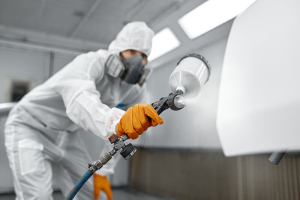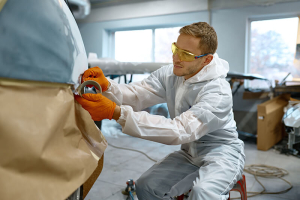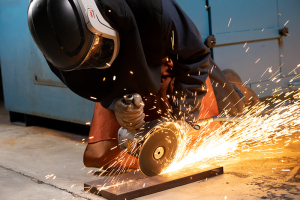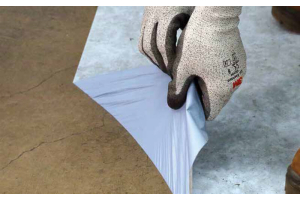Does My Business Need An OSHA Respirator Program?
One of the main questions we hear customers as is Does my business need an OSHA respirator program?
It sounds like a fairly straight forward question that is either yes or no but in fact you do have several options. One of the first questions to ask is, are dust or vapors are a byproduct of your work, if so then you will need to research a respirator program. There can be simple solutions, but the bigger question is how much work will be involved. Take the time to put it together properly now and you will survive any inspections and avoid fines, but if you don’t then you get to put it together properly later AND pay a fine now!
Before implementing a full blown program check to see if there are any “Engineering Measures” that can be taken to eliminate or reduce the issue.
Your first step when considering a respirator program is to look for ways to remove the airborne hazards before they reach a worker’s lungs.
Spray or lab booths are a great example as they collect vapors and overspray particulate using fans or filters and exhaust the air to a non-work area, usually outdoors. Dust collectors or downdraft tables do the same thing for particulates. This is OSHA’s preferred fix because it doesn’t require further monitoring normally. It should be your first option too because paying money up front to remove the expense and hassle of a respirator program is money very well spent.
Often people don’t know what to do or were do start and the as “Who Do I Call For Help?” The best thing is to check with your insurance provider to see if they offer help with OSHA compliance. Your other alternative is the department of labor/industry office or the university system in your state (each state has an OSHA Consultation program that is run by one of the above state entities and is not punitive and provides free services from on-site consultations and training to industrial hygiene services such as air sampling for compliance with OSHA requirements), though it seems counter intuitive calling in the state inspectors it shows good will on your part and they should actively work with you as you seek compliance. Here in Maine we have The Maine Department of Labor’s Workplace Safety & Health Division’s SafetyWorks! Program (whose task is to work with employers who request services in a Consultative – NOT an Enforcement – manner) to overcome problems and protect workers. I regularly suggest customers call in SafetyWorks! inspectors for three reasons, they are there to help your business conform, they won’t impose fines and they have the ability to get your workplace exempt from normally scheduled OSHA Enforcement activities ( see the SafetyWorks! web page for Consultations at: http://www.safetyworksmaine.com/consultations/index.html ) Again, SafetyWorks! is not OSHA and cannot issue fines or citations.
The first step in determining your course of action is to do some research.
I would start by reading Safety Data Sheets (formally known as MSDS Sheets). Your vendors should be sending these along regularly when you order supplies. Section 2 on the SDS will describe any hazards associated with the product and section 8 offers exposure control and personal protection suggestions. Use this information to decode your next step of air sampling. Toxicity is the concern here so look for anything suggesting you shouldn’t inhale the stuff. Your compound could have a toxic vapor or poisonous dust, or it could release either if it’s sawn, ground, scraped, or sanded. If you are only dealing with vapors such as solvents or paints, you might only need to measure organic vapors. This can be accomplished using ‘Drager tubes’, electronic monitors, or even simple 3M badges all of which you can purchase and operate. If you have dusts, mists, or paint overspray then you will need more sophisticated air sampling equipment provided by your insurer or OSHA’s Consultation Program.
The Second step is to do some air sampling to determine your air quality
Close any open windows and doors just like its winter before you begin so your shop is at its worst. Special equipment is sometimes needed here depending on what your contaminants are. You are trying to discover the ‘Time Weighted Average’ (TWA) level of those contaminants. Organic vapors are easy to measure using 3M badges. Photo of a badge Clip a badge on a worker, remove the peel off label, and leave it on for the day. At the end of the shift, reseal the badge making a note of the exposure time and up to three compounds you are looking to measure. Ship it off to the lab for analysis and your results come back in a few weeks. Electronic monitors and sampling tubes 3M 6001I Organic Vapor Cartridge with Service Life Indicatorgive immediate results and are useful if you need to keep records over the long term. This is a good time to give a plug to the pros; insurance carriers and OSHA Consultation Services have inspectors who are trained occupational hygienists that can run the sampling, extract the right data and calculate that all important TWA which is derived from the exposure level of the compounds over a specific time – usually 8 hours. This base line reading tells you how much of a respiratory protection program you will need to establish. The other important detail that you extract from the air sampling data is cartridge life. Your workers will need to know when to change chemical cartridges, and it’s up to the plan administrator to tell them. If you are using 3M equipment, take the exposure level to the 3M Service Life Software site a nd plug in your info to determine how often the cartridges will need changing. In addition, you can also use their new Service Life Indicator cartridges for organic vapors. Th
nd plug in your info to determine how often the cartridges will need changing. In addition, you can also use their new Service Life Indicator cartridges for organic vapors. Th
ese cartridges have built in red indicators telling your workers when to safely change them out for fresh ones.
Do I Fall under a Voluntary Use or Full Blown Program. When you have the results from the air sampling you can determine what your program will entail. I’ve heard business owners suggest they operate under OHSA’s “appendix ‘D’ voluntary use” clause. This suggests that no respirator program is necessary because the exposure falls below OSHA guidelines but workers are free to use filtering facepiece (disposable) respirators like dust masks. It’s a great program aimed at workers who feel more comfortable wearing protection from nuisance levels of contaminants, but you better have the data to back up the claim. I have read that OSHA is concerned about employers who make the claim without actually doing their homework. To me that sounds like OSHA is considering action against companies who don’t actually measure exposure levels. Don’t be that company because OSHA can fine you heavily and still make you do the work.
Ok so you have determined you either need to do a full respiratory. Now what?
The Basic Parts of a Full Program. It’s the law to follow OSHA regulations here so this is what they say:
■ Written worksite specific procedures; write down your procedures based on the exposures encountered and the protection required. Keep in mind that some respirators are more comfortable to wear than others especially if workers are exerting themselves.
■ Program evaluation; this means someone needs to be put in charge of maintaining the program and ensuring compliance and participation by all affected employees. OSHA suggests this person should be familiar with all details of the program and have working knowledge of the equipment provided.
■ Selection of an appropriate respirator approved by NIOSH; NIOSH writes the standards that OSHA enforces. Check to make sure your equipment is imprinted with an approval number and that all the various pieces have been approved to work as a whole; unapproved sub-assemblies might not perform properly at critical times.
■ Training; workers who use respirators need annual training on the proper use, maintenance, and limitations of the equipment they will wear. Each worker should know how to perform fit checks, be familiar with the function, know the correct cartridges too use, and understand where the respirator is appropriate and more importantly where it isn’t approved.
■ Fit testing; if a respirator doesn’t fit then it doesn’t work. Have at least two choices in each size face piece so workers can pick the one that feels best. They will wear a good fitting one, it will be  harder to get them to wear it if something that doesn’t feel right.
harder to get them to wear it if something that doesn’t feel right.
Tight fitting face pieces can’t be worn with facial hair that is breaking the seal to the face, don’t even attempt a fit test since it’s already a violation. Your administrator should conduct fit testing and training annually.
■ Inspection, cleaning, maintenance, and storage; large companies sometimes perform this responsibility while most small companies choose to train workers in this function. Workers should be able to disassemble, clean, and reassemble their respirator and know where to store it when it’s not in use. They should have working knowledge of the various pieces and have access to necessary spare parts as needed. The program also needs to have a storage plan for respirators when not being used, preferably in a sealed box away from the work areas.
■ Medical evaluations; Workers assigned to tasks that require respirator use must be physically able to perform the work while using the respirator. A medical evaluation can be performed by a physician or other licensed health care professional by using a medical questionnaire or by a medical examination. This evaluation must be done before the employee is fit tested and uses the respirator in the workplace. 3M has a great website to help with the medical evaluation process.
■ Work area surveillance; make sure workers are properly using the required equipment. Look for unusual levels of contaminants or other unsafe situations. Don’t let workers leave respirators in work areas, they need to either wear them or put them away. A dust mask hung on a nail or lying on a workbench is a potential $1000 violation, and its easy pickings for OSHA Enforcement inspectors because you cannot contest the call.
■ Air quality standards; make sure exposure levels aren’t beyond the limits of the respirators you have supplied. Check the exposure levels occasionally to insure your program is appropriate act immediately when products and processes change. Watch for obstructions near ventilation or unusual concentration of contaminants to avoid over exposure to workers.
Once you have completed all this, your program needs to be maintained as contaminants, processes, or work responsibilities change. Your administrator should be pay attention to changes in the regulations and adjust the program as necessary.
This is a big undertaking, without question it can consume large blocks of time and money. Your efforts are best spent looking for ways to reduce hazardous atmospheres and make workplaces safer. Catch dust at the source, look for HAP free (hazardous airborne pollutant) options for your finishes or adhesives, extract solvent vapors and paint overspray using hoods, anything and everything possible to get below permissible exposure levels and keep the air clean.









